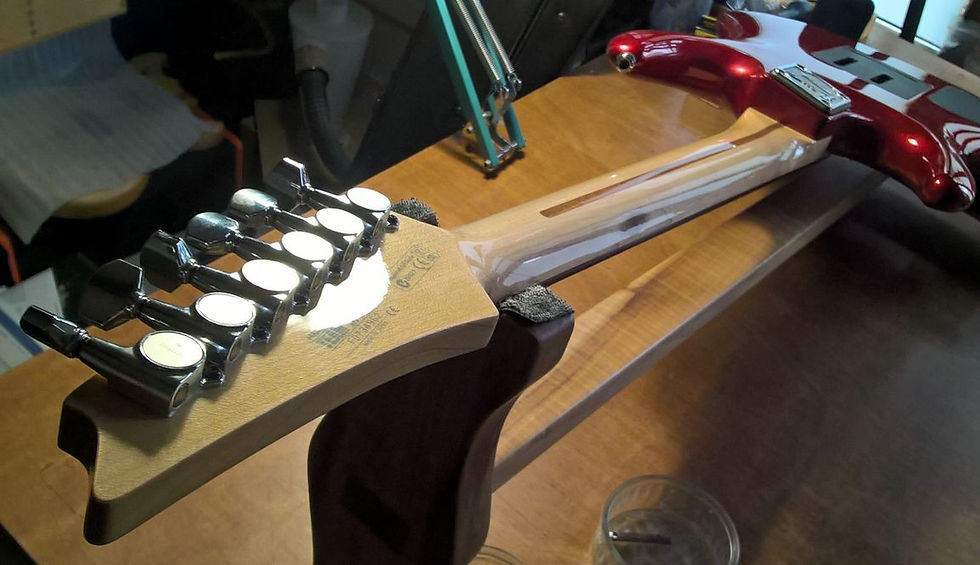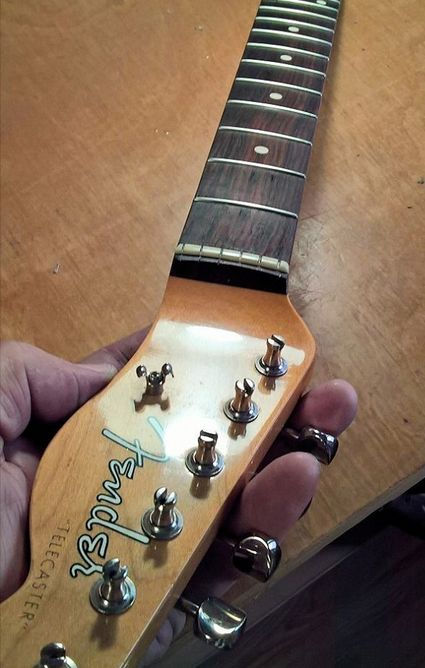In this blog we’ll look at what causes pickups to hum and how to deal with it.

We’ve had a couple of guitars in the workshop recently which have had hum issues, so it’s worth recapping how and why this happens. How pickups convert the vibration of strings into sound via an amplifier is another blog, so let’s take that as a given and look at the reasons why hum occurs and how it can be tamed.
For reasons we will come on to in the next blog, hum is normally only an issue with ‘single coil’ pickups. By single coil, we mean a pickup which contains one magnet with one length of wire wound around it. Single coil pickups are typically found, for example, in classic Stratocasters and Telecasters. ‘Humbuckers’, which contain two separately wound magnets, were invented to overcome pickup hum and first appeared in Gibson guitars in the 1950s.
Unwanted pickup noise is normally produced by two things: 50 cycle AC power (or 60 cycle, if you are in the US); and electromagnetic interference (EMI). You can only hear it when the pickup is idle and not generating its own sound. Usually, a guitarist will notice the hum and EMI gets worse in a rehearsal studio or at a gig. This is because at these venues, there are a lot of devices plugged in to the power network, reinforcing the 50 cycle oscillation, and usually also producing their own EMI. Lighting and computers are also a known problem. Sometimes, in extreme cases, your guitar will pick up the local cab drivers or other radio transmissions. A rehearsal studio I use has an electrified railway track above it, which produces an uncomfortable amount of noise through the amps when it rains!
The way to tackle hum is to first ensure everything that should be grounded in the guitar is joined properly (i.e. strings, via the bridge, and all the electronic cases in the control cavity), but only joined once – creating ‘ground loops’ can in itself produce hum. There are various ways to test this with multimeters, which we won’t go into here, but there are plenty of online resources on this. Once you have eliminated poor grounding you can look at what surrounds the pickups and their controls. Single coil pickups and their controls should ideally be ‘shielded’.
By shielding we mean creating a metal ‘compartment’ around the controls (and, if you really want to, around the pickups too). You will often see partial shielding in the form of an aluminium sheet applied to the back of Stratocaster-style guitars’ scratchplates. This is only partial EMI shielding - it isn’t very effective because the cavity is generally not shielded, but it’s better than nothing.

You can do proper shielding with either: metallic shielding paint; or copper foil. Paint is easily applied and you can get it into the wire cavities as well. However, it is not as good a conductor as copper and can lose its properties over time. We see a lot of guitars which are ostensibly painted with conductive black or grey paint which, when tested with a multimeter, conduct nothing. That is why we prefer adhesive copper sheeting and tape, which is conductive on both sides and lasts forever. If applied properly, copper will create a ‘Faraday cage’ around a control cavity which will block EMI. Copper shielding also eliminates the need to solder ground wires between potentiometers, because your pots will be grounded via the copper (as long as the pots are tightened sufficiently!).
Another manufacturer tactic is to use shielded cable. This is most often seen in Gibson guitars. The centre of the wire carries an insulated ‘hot’ signal and the outer metallic braid carries the ground. The braid can be soldered to the back of potentiometers, meaning the whole wire path is prevented from acting as an EMI antenna. In our opinion this is a bit OTT, and you are limited in this by the wiring that comes with your pickup (unless you want to get really serious and change the wires on the pickup yourself).
It’s rare to be able to eliminate hum completely, but shielding will definitely make a big contribution. Some pickups seem more or less prone than others. Shielding Fender or Squier Jaguars seems to make a tremendous difference, although possibly this is also because those pickups have a bit of built in shielding.
Whatever you try to do, you will be lucky to completely eliminate hum and EMI with single coil pickups, but shielding will definitely help tame the beast. In our next blog we will look at how to use the mix position to turn two single coils into a humbucker and eliminate hum and how polarity effects pickup sound.
You can get your guitar shielded at String King Guitar Works. Check the Services page for pricing.










